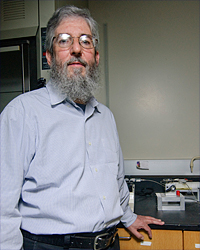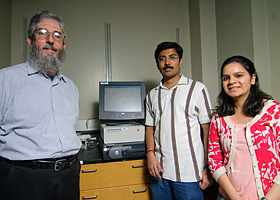Feature Story
Health Center Today, May 20, 2010
New Biomarker Technique Could Provide Early Detection for Cancer
By Christine Buckley

Jim Rusling, professor of chemistry.
Photo by Jessica Tommaselli
Modern genetic testing can predict your risk of contracting particular diseases based on predispositions discovered in your DNA. But what if similar biotechnology could tell you that you’ve got a disease before you notice any symptoms? What if it could even tell you, before any signs of a tumor, that you have cancer?
Jim Rusling, professor of chemistry at UConn and professor of cell biology at the UConn Health Center, ponders these questions on a daily basis. Since 2006, he and colleagues at the University and the National Institutes of Health (NIH) have been developing techniques to detect biomarker proteins – the physiological traits that indicate that a person has a specific disease – for prostate and oral cancer. Because these biomarkers are often present in the blood in a disease’s early stages, they can be used for early detection and prevention.
"DNA predicts which proteins can be made, but it can’t predict which proteins are actively expressed," Rusling says. "It only assesses the risk of a disease. There’s a big push now to measure proteins as biomarkers."
In a recent publication in the journal Analytical Chemistry, Rusling and his colleagues describe a system they developed to detect with record sensitivity the bloodstream levels of a protein associated with several types of oral cancer, including head and neck squamous cell carcinomas. The project was funded by a $1.5 million grant from the National Institute of Environmental Health Sciences at NIH.
The protein, called interleukin-6 or IL-6, is normally present in very low levels in the bloodstream – so low that previous biomarker sensors might not be able to detect it. This and other biomarkers are signaling molecules, which can instruct cells that have become cancerous to grow faster. Their levels can increase even before tumors begin to form, enabling early detection that might head off the formation of cancerous growths.

Professor Rusling, left, with graduate students Bhaskara Chikkaveeraiah, center, and Ruchika Malhotra in their lab in the Chemistry Building.
Photo by Jessica Tommaselli
In their paper, Rusling, UConn graduate student Ruchika Malhotra, and colleagues Vyomesh Patel, Jose Pedro Vaqué, and Silvio Gutkind of NIH report the development of a new sensor, in which a cluster – or as the researchers call it, a "forest" – of densely packed nanoscale carbon tubes was exposed to a patient’s serum. Several steps, including introducing antibodies, other nanotubes, and the patient’s serum itself, resulted in the IL-6 proteins getting caught between two of the carbon nanotubes. The researchers then applied an electrical current to the forest, and enzyme-labeled tubes that had captured IL-6 proteins produced an electrical signal. This method, says Rusling, can detect the lowest levels of IL-6 in the blood, which is less than a trillionth of a gram in one fluid ounce of patient serum.
"The electronics is simple: people have known for 200 years that when you apply a voltage to a metal, you get a current," Rusling says. “Now we’re adapting this approach to microfluidic systems that measure proteins.”
The researchers chose IL-6 specifically because of its unusually low normal levels; they wanted to be sure that their technique could accurately identify trace proteins. This gives the researchers a baseline with which to compare the elevated levels observed in people’s blood just before they develop cancer.
The exciting thing about biomarker techniques such as this one, says Rusling, is that they can be applied to any cancer. Since many biomarkers are common to more than one cancer, he hopes that a panel of these types of assays could detect the markers of the world’s most common and worst cancers.
Currently, instruments that can perform these tests exist in some laboratories, but the commercially-available versions have yet to make it to clinical practices, partly because they’re still very expensive and technically demanding. But they also don’t yet have a useful clinical output, which is a key for clinicians. Testing for five to 10 common biomarkers could lead to a 99 percent accurate predication rate for cancers, Rusling says, but the risk of false positives and negatives needs to be sufficiently low to convince doctors to use the techniques.
"Suppose you measure eight biomarkers for oral cancer," he says. "How do you take that data and make it into one number that a clinician can trust and interpret?"
The next stage is to create an automated system that can perform all these steps within a simple, small, point-of-care device, says Rusling. Currently, blood samples and antibodies need to be specially prepared and fed manually into the group’s testing setup. He envisions that in clinics, an automated tester about the size of a cell phone could accept a sample of a person’s blood, analyze the sample, and read out the results.
Rusling hopes that this proof-of-concept project will help stimulate collaborations from engineers and commercial enterprises willing to work on creating an automated tester. These testers could make early detection much easier, he says, which could go a long way toward saving lives.
"There’s not going to be one cure for cancer, because cancer is thousands of diseases," he says. "The best thing for patients is early detection. Biomarker proteins could become the standard of early detection and treatment monitoring in the future."


